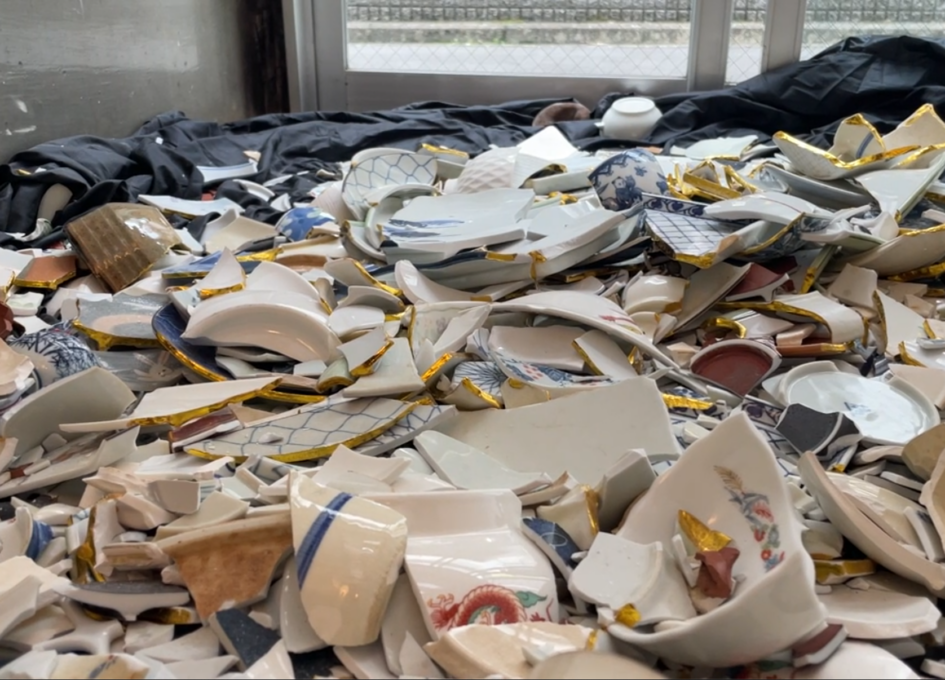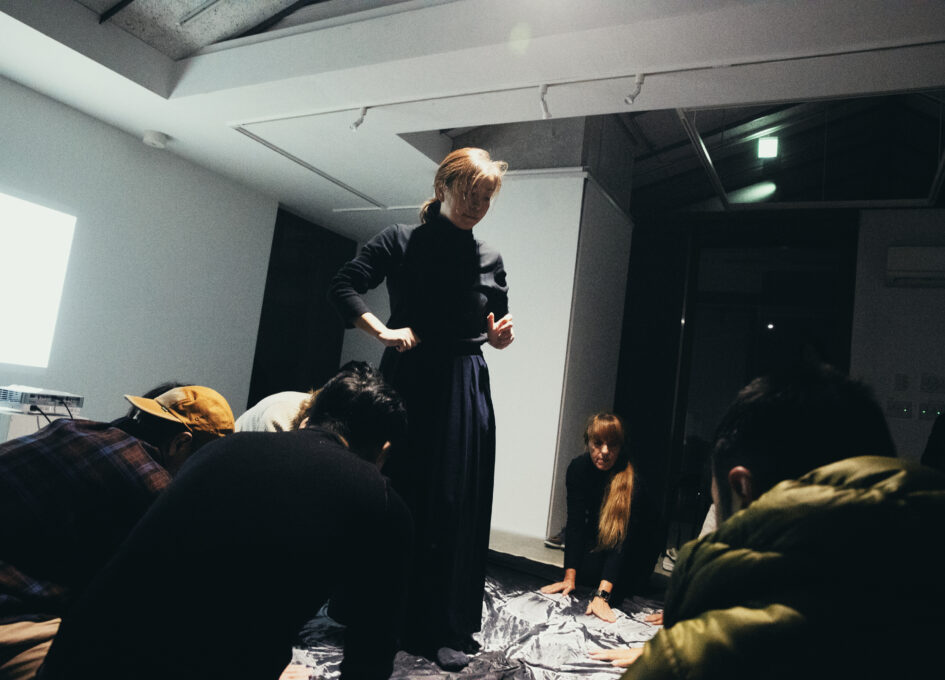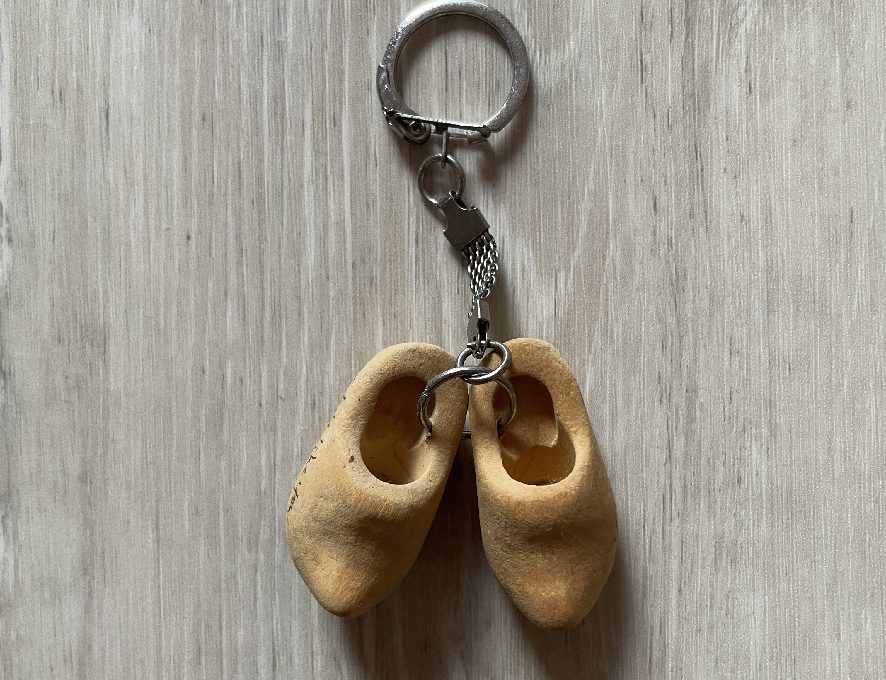こわすことは、きもちいい。
Break Things Feel Good.
参加者は黄金町界隈から集めた陶器を、吹き抜けの3階から1階に落として割り、アーティストはそれらの破片に対し、金を施しながらも修復せず破片の山に戻す「金継がない」行為を会場に滞在しながら続けます。
Participants drop a ceramic collected from local neighborhoods from the third floor into the atrium to break. During the exhibition, the artist stays present, applying gold to the broken edges without joining them back together ̶ an ongoing act of “Un-Kintsugied” ̶ and returning the fragments to the growing pile on the first floor.
日本において、陶器を投げて破壊する行為は、厄除けとして各地の神社で行われています。また、ヨーロッパでも同様のコンセプトで結婚式などで行われます。また、陶器を割る作品としてはアイ・ウェイウェイの「漢時代の壺を落とす / Dropping a Han Dynasty Urn (1995)」や、オノ・ヨーコの「Mend Piece for London(2021)」などがあります。
In Japan, the act of throwing and breaking ceramics has traditionally been practiced at shrines as a form of exorcism or purification. Similar customs also exist in parts of Europe, where ceramics are broken during weddings and other rituals. In the field of contemporary art, Ai Weiwei’s Dropping a Han Dynasty Urn (1995) and Yoko Ono’s Mend Piece for London (2021) are among the well-known works that engage with the act of breaking and mending ceramics.
金継ぎを使ったアート作品もさまざまなものがありますが、「金継がない / Un-Kintsugied」が異なるのは、まず黄金町という風俗街の過去を持つ場所で生まれたということです。元違法風俗店だった三階建の建物は床面積のほとんどが吹き抜けというユニークな空間でした。
While many artists have incorporated kintsugi (the Japanese art of repairing broken pottery with gold) into their practice, Un-Kintsugied differs in several significant ways. The work originated in Koganecho, a district once known as a red-light area. The three-storey building that served as the site of the performance was formerly an illegal brothel, and its unique architecture featured a central atrium that extended through nearly all of its floors.
加えて、参加者が増えていくとともに、割れた陶器の山は瓦礫になり、過去の風俗街の雰囲気を彷彿とさせる風景を作り出しました。これは人を怖がらせると同時に魅力的に映る結果となり、最終的には予想をはるかに上回る合計155名の一般人が参加しました。
As the number of participants increased, the pile of broken ceramics gradually turned into rubble, evoking a chaotic and unsettling atmosphere reminiscent of the district’s past. This scene — both intimidating and strangely alluring — ultimately drew 155 participants in total.
テーマパークスタッフのような愛想の良い事務的な案内、安全確保のためロックされる密室空間、そして自分のものではないオブジェ… 参加者はそれらのセットアップに導かれて潜在的な暴力性の最後のボーダーを超える経験をしました。
Within the setup — polite, theme-park-like instructions, a locked and controlled space for safety, and the act of breaking objects that did not belong to them — participants crossed a final threshold of latent violence.
アーティストは破壊された破片に金箔を施し、瓦礫の山に戻しますが、これは参加者と協力する行為でも対抗する行為でもありません。しかし多くの参加者が、自分の破壊行為が許される理由をそこに見出していました。
The artist applied gold leaf to the broken fragments and returned them to the growing pile of debris — an action neither collaborative nor oppositional, but simply part of the process. Yet, many participants found in this gesture a form of justification for their own destructive act.
破壊後の瓦礫に対して、参加者は様々な風景、福島の津波跡、パレスチナの紛争地帯、ウクライナの街などを重ね合わせました。しかし同時に、破壊行為がもたらす快感はとても強い印象を参加者に与えたようで、複数回訪れる参加者もいました。
Faced with the mound of broken pieces, participants associated the scene with other landscapes of devastation — the tsunami aftermath in Fukushima, the conflict zones of Palestine, or the ruined cities of Ukraine. At the same time, the visceral pleasure of destruction left a strong impression, prompting some participants to return multiple times.
破壊後の破片を片付けるための数分の待機時間中に書かれたノートには、破壊行為に対する興奮と背徳感の両方が参加者によって書かれています。
In a notebook placed at the site, participants wrote during the short waiting period while the artist cleared the fragments. Their notes reveal a mixture of excitement and guilt — a record of both the thrill and the transgression of breaking.
金継がない / Un-Kintsugied
黄金町バザール+上大岡バザール2025 通過中 We Meet Along the Way – 自主企画
Koganecho Bazaar + Kamiooka Bazaar 2025 We Meet Along the Way – Independent exhibitions



